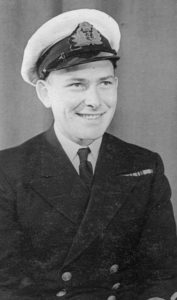As a boy I lived within minutes of the sea and that is where it must have all begun, for in 1941 I joined the Sea Cadets. It was the nearest a 17 year old could get to the Royal Navy. Despite friends in the RAF and my father having joined the Royal Artillery in the First World War, nothing other than the Navy crossed my mind.
In October 1942 HMS Collingwood was a vast training camp for the thousands of young men who shambled through the gates in groups from Fareham station to emerge 11 weeks later as divisions of fit, clean, young fighting sailors, feet crunching in unison, arms swinging and eyes to the right in salute to our respected Commodore – affectionately known as ‘Bluenose’. This may have been an acknowledgement of the fact that no matter how cold or frosty the weather, parades at 0630 and 0800 were ordered ‘negative greatcoats’. Oilskins were ordered only if rain was falling – to prolong the life of scarce wartime serge, not to pander to the weakness of the flesh!
Having marched out in hundreds feeling very pleased with ourselves, a dozen of us returned after Christmas for further training. We had been selected as Cadet Ratings for Mountbatten’s new Command called Combined Operations. We were posted to HMS Lochailort in the Western Highlands. There seamanship, communications (radio, morse by lamp, semaphore and flag-hoists), pilotage, astro-navigation, demolition, unarmed combat, small arms and meteorology were all spaced out by hideous bouts of physical training twice daily. These were directed to turning us into Naval Commandoes able to fight alongside the Army and Marines once onshore. Those who successfully survived all these onslaughts were commissioned as Midshipmen RNVR (or Sub-Lieutenants if they were over 19½ years of age). The top ten in navigation were retained for extra astro-navigation as they were destined for Major Landing Craft, i.e. those crossing the Channel under their own steam, not ferried to the beachhead.
Thus on D-Day I was a Sub-Lieutenant serving in HMLCT(R) 337, which formed part of the 320th LCT(R) Flotilla off JUNO beach. These formidable rocket-firing craft displaced only 500 tons, but they could launch one thousand 5-inch rockets, each weighing 56lbs, to saturate a target area of 1000×400 yards in a creeping barrage. Each craft had its own radar to measure the distance off the beach for accurate ranging, and I was fascinated to find that it was the RAF’s H2S radar with the scanner upside down! The job of the First Lieutenant was to make the firing switches in 30 salvoes of 36 at precisely 6-second intervals. I recollect doing that with one hand, whilst the other clutched a bucket as well as the Admiralty Pattern Stopwatch!
D-Day over, we were soon back off the beachhead and had to endure the famous storm by ceaselessly patrolling back and forth off the Calvados Reef. Since we were fully loaded, fuzed and armed, nobody wanted us in harbour! All LCTs rolled like cows. LCT(R)s with their very high windage not only rolled very badly but also made three or four knots broadside-on downwind if the engines were stopped. In the big waves it took nearly a mile to turn to starboard because of the twin right-handed screws.
The storm over, we had the doubtful distinction of being the only rocket craft to detonate one of the new mines being scattered up and down the coast by the Luftwaffe. It blew up just underneath the stern-wire capstan on which I was sitting carefully reading a signal being flashed by Aldis lamp from a fussy little HQ LCI(L). She had emerged from the safety of the Mulberry Harbour to find out if all was well. This explosive experience later proved a useful story to enliven scientific study groups on mine warfare! Ashore in a survivors’ camp, I heard that my CO had been killed in yet another mining incident. Thus I found myself in command of the remaining crew and later returned to the UK with our damaged and useless ship, borne high and dry within an LSD (Floating Dock Vessel).
A few months later I sailed for the Far East in command of another ‘tropicalized’ Rocket Ship to join in the assault on Japanese-occupied Malaya. Spending my 21st birthday in the Red Sea, we sailed in Operation ZIPPER after the Japanese had surrendered. So in the event the landing was unopposed. We later re-visited Mandapam (SE India), and Colombo and Trincomalee. Having paid off in Cochin and said farewell to the Ship’s Company, who returned to the UK in another LSD, I went on in an American LCI(L) to Singapore and Luzon in the Philippines to return her under Reverse-Lease-lend to the US Navy.


